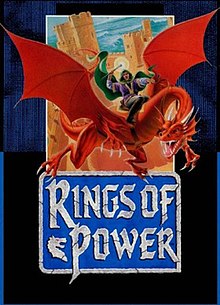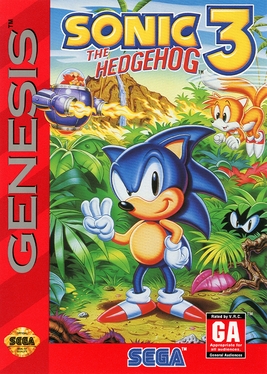
Sonic the Hedgehog 3 is a 1994 platform game developed and published by Sega for the Genesis. Like previous Sonic games, players traverse side-scrolling levels while collecting rings and defeating enemies. They control Sonic and Tails, who attempt to retrieve the Chaos Emeralds to stop Doctor Robotnik from relaunching his space station, the Death Egg, after it crash-lands on a mysterious floating island. Sonic 3 introduces Knuckles the Echidna, the island guardian, who lays traps for Sonic and Tails.

Sonic the Hedgehog is a 1991 platform game developed by Sonic Team and published by Sega for the Genesis/Mega Drive. It was released in North America on June 23 and in PAL regions and Japan the following month. Players control Sonic the Hedgehog, who can run at near supersonic speeds; Sonic sets out on a quest to defeat Dr. Robotnik, a scientist who has imprisoned animals in robots and seeks the powerful Chaos Emeralds. The gameplay involves collecting rings as a form of health, and a simple control scheme, with jumping and attacking controlled by a single button.

Road Rash is a motorcycle racing video game series by Electronic Arts in which the player participates in violent, illegal street races. The series started on the Sega Genesis/Mega Drive and was released on various other systems over the years. The game's title is based on the slang term for the severe friction burns that can occur in a motorcycle fall where skin comes into contact with the ground at high speed.

Mark Evan Cerny is an American video game designer, programmer, producer and media proprietor.
Naughty Dog, LLC is an American first-party video game developer based in Santa Monica, California. Founded by Andy Gavin and Jason Rubin in 1984, the studio was acquired by Sony Computer Entertainment in 2001. Gavin and Rubin produced a sequence of progressively more successful games, including Rings of Power and Way of the Warrior in the early 1990s. The latter game prompted Universal Interactive Studios to sign the duo to a three-title contract and fund the expansion of the company.

Sonic the Hedgehog 2 is a 1992 platform game developed by Aspect and published by Sega for the Master System and Game Gear. It is the sequel to the 8-bit Sonic the Hedgehog (1991) and follows Sonic as he attempts to get the Chaos Emeralds back to rescue his friend Miles "Tails" Prower from Dr. Robotnik. Like the first Sonic the Hedgehog, players run through levels at high speeds while collecting rings and defeating enemies. Although it shares the same title with Sonic the Hedgehog 2 for the Sega Genesis and their releases coincided, the games have little in common and share no levels.

The Genesis, also known as the Mega Drive outside North America, is a 16-bit fourth generation home video game console developed and sold by Sega. It was Sega's third console and the successor to the Master System. Sega released it in 1988 in Japan as the Mega Drive, and in 1989 in North America as the Genesis. In 1990, it was distributed as the Mega Drive by Virgin Mastertronic in Europe, Ozisoft in Australasia, and Tectoy in Brazil. In South Korea, it was distributed by Samsung Electronics as the Super Gam*Boy and later the Super Aladdin Boy.

Sonic the Hedgehog 2 is a 1992 platform game developed by Sega Technical Institute (STI) for the Sega Genesis. Players control Sonic as he attempts to stop Doctor Robotnik from stealing the Chaos Emeralds to power his space station. Like the first Sonic the Hedgehog (1991), players traverse side-scrolling levels at high speeds while collecting rings, defeating enemies, and fighting bosses. Sonic 2 introduces Sonic's sidekick Miles "Tails" Prower and features faster gameplay, larger levels, a multiplayer mode, and special stages featuring pre-rendered 3D graphics.

Andrew Scott Gavin is an American video game programmer, entrepreneur, and novelist. Gavin co-founded the video game company Naughty Dog with childhood friend Jason Rubin in 1986, which released games including Crash Bandicoot and Jak and Daxter. Prior to founding Naughty Dog, Gavin worked in LISP at the MIT Artificial Intelligence Laboratory.

X-Men 2: Clone Wars is a 1995 platform game developed by Headgames and released by Sega of America for the Mega Drive/Genesis as a sequel to the 1993's X-Men. The game is based on the adventures of the Marvel Comics superhero team, the X-Men. A sequel, titled X-Women, was cancelled.

Crash Bandicoot is the title character and main protagonist of the Crash Bandicoot series. Introduced in the 1996 video game Crash Bandicoot, Crash is a mutant eastern barred bandicoot who was genetically enhanced by the series' main antagonist Doctor Neo Cortex and soon escaped from Cortex's castle after a failed experiment in the "Cortex Vortex". Throughout the series, Crash acts as the opposition against Cortex and his schemes for world domination. While Crash has a number of offensive maneuvers at his disposal, his most distinctive technique is one in which he spins like a tornado at high speeds and knocks away almost anything that he strikes.
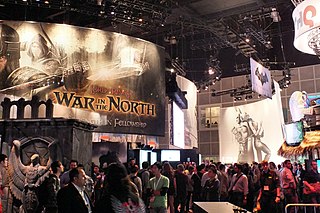
There are many video games that have been inspired by J. R. R. Tolkien's works set in Middle-earth. Titles have been produced by studios such as Electronic Arts, Vivendi Games, Melbourne House, and Warner Bros. Interactive Entertainment.
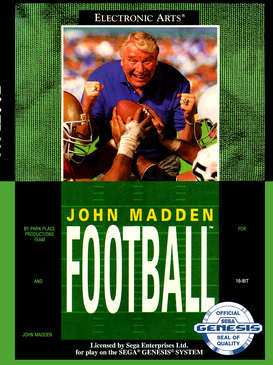
John Madden Football, released as John Madden American Football in Europe, is an American football video game released by Electronic Arts. Loosely based on the 1988 video game of the same title, it was the first entry in what eventually became the yearly Madden NFL series on home consoles, initially released for the Sega Genesis in 1990. It is sometimes called Madden '90 or Madden '91 to distinguish it from subsequent entries in the series.
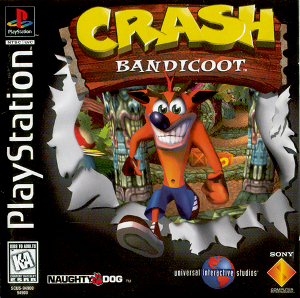
Crash Bandicoot is a 1996 platform video game developed by Naughty Dog and published by Sony Computer Entertainment for the PlayStation. The player controls Crash, a genetically enhanced bandicoot created by the mad scientist Doctor Neo Cortex. The story follows Crash as he aims to foil Cortex's plans for world domination and rescue his girlfriend Tawna, a female bandicoot also created by Cortex. The game is played from a third-person perspective in which the camera trails behind Crash, though some levels feature forward-scrolling and side-scrolling perspectives.

Skitchin' is a 1994 racing video game developed and published by Electronic Arts (EA) for the Sega Genesis. The game puts the player in control of an inline skater who must win races in a tournament while engaging in unarmed and armed combat with other skaters and partaking in skitching, the act of clutching onto a moving vehicle's bumper to gain momentum.

Jason Rubin is an American video game director, writer, and comic book creator. He is best known for the Crash Bandicoot and Jak and Daxter series of games which were produced by Naughty Dog, the game development studio he co-founded with partner and childhood friend Andy Gavin in 1986. He was the president of THQ before its closure due to bankruptcy on January 23, 2013. Rubin is the vice president of Metaverse Content at Meta Platforms.
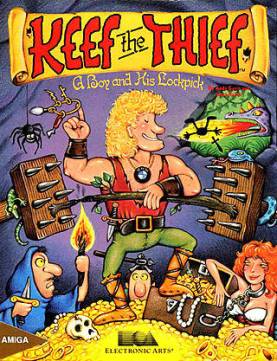
Keef the Thief: A Boy and His Lockpick is a video game developed by Naughty Dog and published by Electronic Arts. It was released in 1989 for the Apple IIGS and then later ported to the Amiga and MS-DOS. Keef the Thief is a comedic sword and sorcery role-playing game.
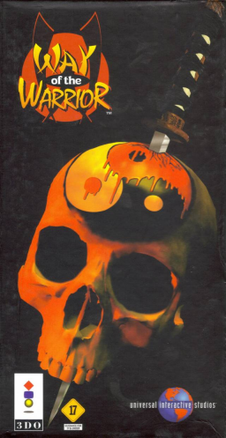
Way of the Warrior is a fighting game developed by Naughty Dog and published by Universal Interactive Studios for the 3DO. It was released in North America on August 30, 1994.

Bruce Straley is an American game director, artist, designer, and studio director. He previously worked for the video game developer Naughty Dog, known for his work in the video games The Last of Us and Uncharted 4: A Thief's End. Straley's first video game work was as an artist at Western Technologies Inc, where he worked on the Menacer six-game cartridge (1992) and X-Men (1993). Following this, he formed a company, Pacific Softscape, where he worked as a designer on Generations Lost (1994). After the company disbanded, Straley was eventually hired at Crystal Dynamics, where he worked as a designer on Gex: Enter the Gecko (1998) and was initially game director for Gex 3: Deep Cover Gecko (1999); he left the company partway through development of the latter.

Road Rash is a 1991 racing and vehicular combat video game originally developed and published by Electronic Arts (EA) for the Sega Genesis. It was subsequently ported to a variety of contemporary systems by differing companies. The game is centered around a series of motorcycle races throughout California that the player must win to advance to higher-difficulty races, while engaging in unarmed and armed combat to hinder the other racers.
